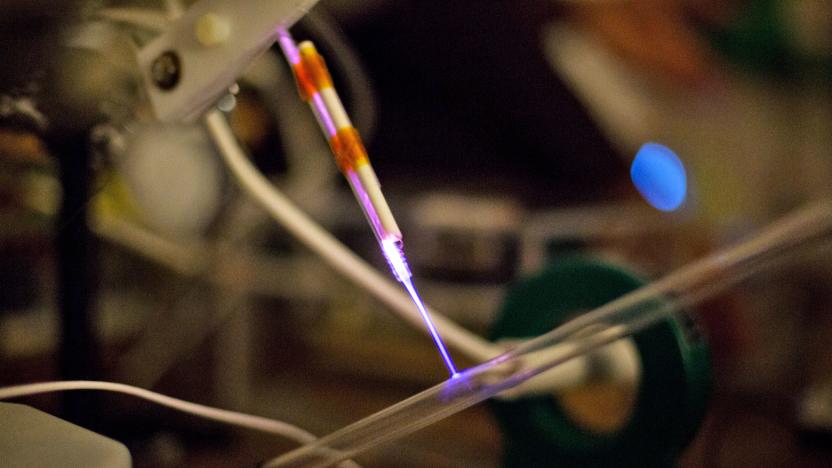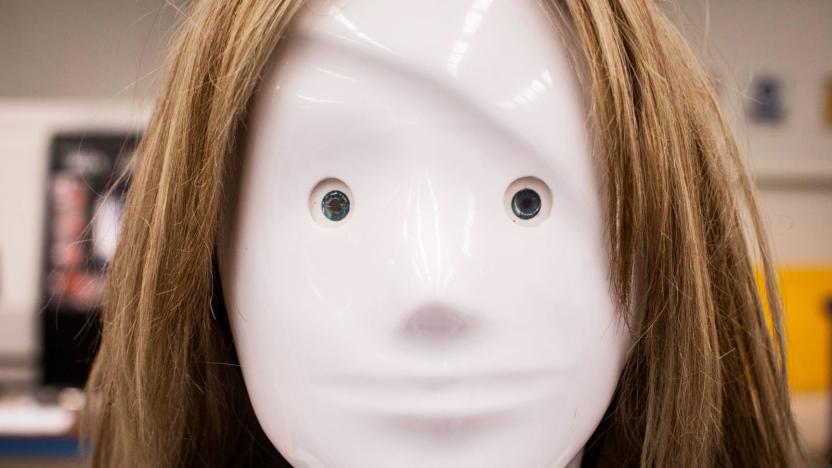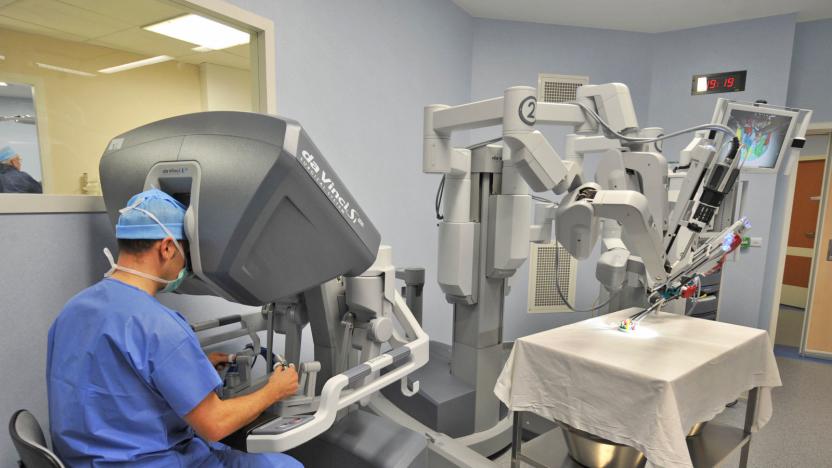hospitals
Latest

Portable 'cold plasma' wand prototype could destroy germs in seconds
Engineers from the University of Michigan created a plasma jet wand to disinfect hospital rooms.

A humanoid is born in a Turkish robotics factory
The Uncanny Valley posits that robots get exponentially creepier the closer they look to humans -- take Nadine the social robot, RealDoll and the Geminoids (please). However, a company called Akin Robotics in Turkey has proved that robots don't need to look like humans at all to evoke the "ugh" factor. It recently unveiled a new factory that will produce an Eyes Without a Face-like model that will surprise, delight and terrify visitors at airports and elsewhere.

DeepMind’s data deal with the NHS broke privacy law
An NHS Trust broke the law by sharing sensitive patient records with Google's DeepMind division, the UK's data watchdog has ruled. The long-awaited decision falls in line with the conclusion drawn by Dame Fiona Caldicott, the UK's National Data Guardian in May. The pair's agreement "failed to comply" with the Data Protection Act 1998, according to the Information Commissioner's Office (ICO), because patients weren't informed that their information was being used. The ICO also took issue with the size of the dataset — 1.6 million partial patient records — leveraged by DeepMind to test Streams, an app for detecting acute kidney injury.

Pacemakers are far more vulnerable to hacking than we thought
Back in January, the FDA has finally acknowledged that some pacemakers and other cardiac devices are vulnerable to hacking. But how vulnerable are they, exactly? A security company called WhiteScope has discovered 8,000 bugs that hackers can exploit in pacemaker programmers -- the tools used to adjust and monitor the device itself -- from four different manufacturers. More importantly, the researchers said they've also discovered that pacemakers don't authenticate programmers, so any working tool listed on eBay has the potential to harm patients with the implant.

Scientists want to define just how smart robot surgeons are
For roughly three decades, medical robots have assisted surgeons in the operating theater. They provide a steady hand and can make tiny incisions with pinpoint accuracy. But as robotics improve, a new question has emerged: How should autonomous robots be treated? The US Food and Drug Administration (FDA) approves medical devices, while medical societies monitor doctors. A robot that can operate on its own falls somewhere in between. To help, Science Robotics has produced a scale for grading autonomy in robot-assisted surgery. If adopted, it could help regulators decide when and how machines should be treated like humans.

Meet the automated triage nurse of the future
If you think that the march of automation isn't going to affect jobs in the medical profession, then, uh, you better sit down. A Belgian company called BeWell is showing off WellPoint, a self-service kiosk that's designed for patients entering hospitals or clinics. The WellPoint is a touchscreen-enabled booth that operates as a first port of call for visitors, quickly checking your basic vitals before you see a medical professional.

NHS to use Uber and startup Cera for at-home patient care
Healthcare startup Cera is teaming up with Uber to deliver patient care on the NHS' behalf. The service, launched in November, matches "hundreds" of carers in the UK with the people who need them most. Today, the company is announcing a partnership with the Barts Health NHS Trust -- which runs Mile End Hospital, Newham University Hospital and others -- so that doctors can effectively prescribe the platform and help their patients receive timely care at home. The hope is that such a service will improve patient care while freeing up hospital beds in London.

NASA's Martian tech is helping hospitals eliminate bedsores
Bedsores, also known as pressure ulcers, kill more people annually than nearly any form of cancer, with 500,000 cases per year in the United Kingdom alone. One problem doctors and nurses face in the fight against bedsores is early detection -- traditionally, hospital staff can only diagnose pressure ulcers once they reach the skin's surface and have done irreparable damage. The SEM Scanner changes this. Using seismology technology adapted from NASA's Mars lander, the wireless, handheld, non-invasive scanner is able to detect bedsores up to 10 days before they show up on the skin.

The robot revolution starts with data entry and small talk
Pepper the home robot is looking for work. According to SoftBank, the Japanese company behind the humanoid bot that looks like a friendlier version of an anime villain, this is the year that robots start working for us. That said, businesses are keeping tasks simple. Easy, uncomplicated, dull, simple. So far Pepper has made its way into 500 companies. This week I toured Pepper's early career options.

Physicians who use mobile apps prefer iPhones and iPads
A recent survey conducted by Black Book Rankings reveals that physicians are increasingly relying on mobile apps in their daily practice. The trend is somewhat attributable to the Affordable Care Act which provides incentives to doctors and hospitals to digitize Electronic Health Records (EHRs) and make them available via mobile devices. As a result, physicians are now using mobile applications in their practice more than ever before. Some functions of medical-based mobile apps include the ability to remotely view and update charts, coordinate schedules and appointments, place lab orders, access patient records and even prescribe medication. The study found that amongst physicians who use medical mobile apps on smartphones, 68 percent use iPhones while 31 percent use Android-based devices. Perhaps not surprisingly, this preference for iOS extends beyond the smartphone realm and includes tablets as well. The survey found that 59 percent of physicians who use mobile apps do so on a tablet device, and from within that group, most prefer the iPad. That the iPhone and iPad are the preferred devices amongst physicians isn't all that surprising given the number of hospitals that are increasingly incorporating iOS devices into the work place. Back in April, for example, we reported on a hospital in Los Angeles which began deploying FaceTime-equipped iPads in its neonatal intensive care unit as a means to facilitate communication between mothers and newborns when face-to-face interaction isn't yet possible. Such scenarios can arise when a new mother has post-operative complications or an infection which may put the newborn infant at risk. Just yesterday, we also reported on how one hospital was able to recoup its investment in iPads in just nine days. Lastly, it's worth pointing out that Apple has a special page on its website highlighting how a prominent Canadian hospital has successfully deployed iPads as a means to help doctors and nurses perform important tasks and increase the overall level and efficiency of care. Physicians at The Ottawa Hospital have started using iPad in innovative new ways. They can use the built-in iPad camera to photograph a patient's wound during treatment, and store the image in the patient's electronic medical record for future reference. Using iPad, physicians can show patients the progress of their recovery right at the bedside, Dr. Geiger notes. "I can say, 'Here's what your wound looked like three weeks ago.' I'm showing them what it looked like then and what it looks like today." iPad fits physicians' workflows in many ways, Potter says: "The form factor of iPad is very attractive. The screen size is optimal. There's almost instant access to information. Battery life exceeds the length of a shift. It's critically important for a physician to be able to know that they can rely on that device, work for an entire shift, and provide the same level of care to all their patients." The video below highlights how The Ottawa Hospital has been using iPads to improve patient care. It's well worth watching.

Sony unveils first medical-grade OLED monitor, surgery gets rendered in all-too-vivid color
OLED screens are virtually everywhere, and they're steadily getting bigger, but it was tough to find any in hospitals until now. While Sony's 25-inch PVM-2551MD might not have the most glamorous name, it's the first and only OLED monitor with FDA approval for use in surgery. No, it's not just to give the doctor something more pleasing (or disgusting) to look at while she's removing a gallstone -- the organic display can be a genuine help for surgery through the higher contrast, virtually non-existent blur and more faithful color reproduction versus the LCDs it's meant to replace. Us patients likely won't see the now-shipping 2551MD for much longer than it takes to go unconscious, so it might be hard to appreciate; if it helps surgeons finish operations faster and with fewer mistakes, however, we could all reap the rewards.

Child's Play 2011 starts annual drive, trying for $2 million in donations
Halloween has passed us by, which means the season of charity is here, and Child's Play has started up its yearly drive for donations. Child's Play, started by the fine folks at Penny Arcade, is dedicated to providing sick children in hospitals all over the world with video games and toys to play while they recover, and has raised nearly $9 million in money and donations since it was founded in 2003. This year, Child's Play is aiming for at least $2 million in donations, in part through a slew of events during the next two months, including the annual Desert Bus for Hope marathon later this month, and a Charity Dinner and Auction on December 8 up in Seattle. The group has picked up $450,000 in donations this year already, putting it well on the way towards its final goal. You'll probably have a few other opportunities to donate over the next few months, but if you would like to jump in and help the kids out now, Child's Play accepts checks, Paypal donations, or you can even text in your donation by sending "GAMERS" to 50555. So go ahead -- even if the bells haven't started ringing in your neighborhood just yet, take this chance to give a little bit to those in need.

Kinect keeps surgeons on task, Nintendo 3DS might assist optometrists with diagnoses
The latest generation of gaming gadgets do some nifty tricks, and one of the niftiest they might perform is assisting the realm of medicine. Microsoft's Kinect sounded like a candidate for surgery, and this month real-life surgeons have actually put it to use -- Sunnybrook Hospital in Toronto, Canada rigged the Xbox 360 depth camera to its medical imaging computer. Now, doctors don't have to scrub out to manipulate an MRI scan, or even appoint a peon to the task -- rather, they simply raise their bloodied glove, and dive into the digital imagery with a wave of a dextrous hand. Meanwhile, the American Optometric Association has expanded upon its initial praise of Nintendo's 3DS, saying the autostereoscopic 3D handheld "could be a godsend for identifying kids under 6 who need vision therapy." Though Nintendo's warning labels had originally incited a bit of fear among parents, the organization says that kids who can't experience the 3DS to its full potential may have amblyopia (or other vision disorders) that can be more easily treated the earlier it's caught, though one doctor interviewed by the Associated Press contends that kids with amblyopia may not know what they're missing to begin with -- so don't necessarily expect a panacea, folks.

iPads join tongue depressors and latex gloves as a hospital fixture
The next time you visit a hospital or medical clinic for a routine check or emergency, don't be surprised if the doctor shows up with an iPad in hand. The Chicago Sun-Times is reporting that in several Windy City hospitals, the iPad is making inroads in a big way. The Loyola University Medical Center has given Apple's tablet to all of its orthopedic residents as a pilot program, while the University of Chicago Medical Center is expanding an existing pilot by providing iPads to all of their internal medicine residents. What are the iPads used for? At the University of Chicago, plastic surgeon Dr. Julie Park shows breast-cancer patients what they may look like after reconstructive surgery. At the Metro South Medical Center, many of the emergency room doctors purchased their own iPads once they found out that they could access the hospital's medical record system from the devices. One Metro South doctor was quoted as saying that the iPads resolved one of the traditional problems with moving from paper to electronic records -- having to go to a desktop computer to order lab tests or update patient notes. Since the iPad is used as a portal device to the record system at Metro South, no patient info is stored on the device. Both the medical record system and iPad are password-protected as well, keeping secure information safe from prying eyes. If you're using an iPad in a hospital or other medical venue, let us know how it's working out by leaving a comment. [via MacDailyNews]

Drug vending machines start trial in UK, allow awkward videophone conversations with your pharmacist
You've got to imagine the Japanese are green with envy right now, as the BBC report not one, but two different drug vending machines are being tested out under Her Majesty's watchful eye. The first of these experiments is run by supermarket chain Sainsbury's, which has installed a pair of drug dispenser machines in its stores. They identify users by their fingerprint or a unique number, demand PIN verification too, and then finally accept your prescription. Then -- and this is the really silly part -- a pharmacist comes along, picks up your prescription, fills it out, and deposits it in the machine for you to pick up. So it's impersonal and unnecessarily convoluted, great. PharmaTrust seems to have a slightly better idea with its videophone-equipped, ATM-style robo-vendor: it's intended to allow pharmacists to approve prescriptions off-site and out of usual working hours by letting them speak to you via videophone. It could in fact be a big benefit in more remote areas, depending on how patients take to it -- we'll know more when the trial starts up in participating hospitals this winter.

Medigenic Infection Control keyboard will be easy to clean when the zombies attack
We don't have a phobia about germs or anything, but this keyboard still really strikes our fancy. Designed by Esterline Advanced Input Systems for use in hospitals, the Medigenic Infection Control keyboard boasts a couple of features that make it less likely to be infested with disgusting germs, as well as easier to clean. First off -- it's a flat surface, and has no "keys" -- just the 3D-looking printed keyboard layout -- so that you don't get crumbs, dirt, or anything else trapped in there. It also has a disable key, so that you can turn off the keys for quick cleaning, and a customizable reminder system to let you know when it's ready for a wipe down. A companion mouse is also available. The keyboard is available for $140, and the mouse is $80. [Via Oh Gizmo!]

Baby incubators made from Toyota 4Runner, Aunty Entity would be proud
Developing nations are often the recipients of used, donated baby incubators, as new ones cost about $40,000 each. Often lacking either the technicians or the parts to fix them, however, most of the incubators don't actually work. Enter Jonathan Rosen of Boston University's School of Management, who's ingeniously devised an incubator out of the very abundant Toyota 4Runner. The device is cobbled together using headlights as the heating source, the filters for air purification and the door alarm for emergency notification. The resulting incubator costs about $1,000 to make and can be repaired by auto mechanics, which is obviously good news for hospitals in need. The bad news? Dr. McDreamy's in the garage, "fixing" your car.

White space networking could disrupt hospital telemetry systems
The stumbling blocks keep piling up as white space networking struggles to get off the ground: it looks like the manufacturers of healthcare equipment are set to join NAB in opposing the technology. Wireless medical telemetry devices like heart monitors have been operating in broadcast white spaces since the late 80s, and manufacturers like GE Healthcare say that the Microsoft- and Google-backed white space networking initiative could potentially "directly interfere" and "prevent patient monitoring." For its part, the FCC has set aside all of channel 37 for medical telemetry devices in 1998 after interference from a nearby TV station shut down the system at Baylor University Medical Center, but it wasn't mandatory, and hospitals that haven't made the switch could face millions of dollars in upgrade costs. That's not say that medical telemetry concerns are a problem that can't be solved -- the new Google push includes a channel 37 exception, for example, and there are some other compromise solutions on the table -- but it seems like there's no end of issues for a technology that hasn't really even been demonstrated working yet.

Microsoft, Companions in Courage partner to bring Xbox Live to children's hospitals
With all of the continual media controversy over violent video games and their negative impact on society, it's refreshing to see these same games in a positive light every now and then. This is especially true when games are used to lift the spirits of hospitalized children, something we've seen in efforts like Child's Play and the Get-Well-Gamers Foundation. Now, Microsoft has become the latest gaming organization to follow its moral compass, inking a partnership with NHL legend Pat LaFontaine's nonprofit Companions in Courage to bring 450 Xbox 360 game kiosks to children's hospitals in the US.The kiosks will come pre-loaded with select games, movies and television content, and will allow children to play games and chat with each other across a private "safety-enhanced" flavor of Xbox Live. The kiosks will be rolled out in waves, with the first wave being kicked off with three simultaneous events today at Morgan Stanley Children's Hospital of New York-Presbyterian, the Children's Hospital of Orange County in California, and the Children's Hospital & Regional Medical Center of Seattle, the latter of which will feature a presentation by Microsoft exec Robbie Bach.

MEDIVista won't ease your pain, but will kill boredom
One of the things most people fail to realize about being sick is that sitting in a hospital bed all day can be really, really boring. Luckily, a company called Lincor Solutions has realized that people need something a little more engaging than plain-jane television these days, thus the MEDIVista was created. The basic premise is quite simple: a touchscreen, LCD display is mounted to the side of a hospital bed which the hospital staff can use to display x-rays or medical information, and the patient can use for entertainment. Users can watch IPTV, listen to the radio or audio books, make VoIP calls, surf the 'net, check email, as well as play web and network based games. The system also logs activity and allows users to view billing information, though at this point it doesn't look like it can play Doom, will blend, or is due to become our overlord.[Via OhGizmo!]










